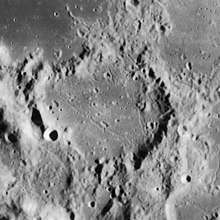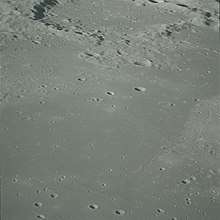Agatharchides (crater)
Agatharchides is a lunar impact crater located at the southern edge of Oceanus Procellarum, in the region between the Mare Humorum and Mare Nubium. To the east-southeast is the crater Bullialdus, and to the south-southwest lies Loewy. It is named after the Greek geographer Agatharchides.[1]
 Lunar Orbiter 4 image | |
| Coordinates | 19.8°S 30.9°W |
|---|---|
| Diameter | 49 km |
| Depth | 1.2 km |
| Colongitude | 31° at sunrise |
| Eponym | Agatharchides |

The interior of the crater has been inundated by lava in the past, resurfacing the floor. The damaged outer wall varies considerably in height, ranging from level with the surface to rising as high as 1.5 km. The most intact portions of the wall are along the east and the west-southwest, while the rim is nearly non-existent to the north and heavily damaged to the south. A small craterlet lies along the western rim. The interior floor is marked only by a few tiny craterlets.
Satellite craters
By convention these features are identified on lunar maps by placing the letter on the side of the crater midpoint that is closest to Agatharchides.
| Agatharchides | Latitude | Longitude | Diameter |
|---|---|---|---|
| A | 23.2° S | 28.4° W | 16 km |
| B | 21.5° S | 31.6° W | 7 km |
| C | 22.0° S | 32.9° W | 12 km |
| E | 20.7° S | 33.0° W | 15 km |
| F | 20.3° S | 31.8° W | 6 km |
| G | 20.1° S | 26.7° W | 6 km |
| H | 20.4° S | 33.9° W | 15 km |
| J | 21.6° S | 32.5° W | 13 km |
| K | 21.0° S | 27.4° W | 11 km |
| L | 21.1° S | 26.7° W | 8 km |
| N | 21.1° S | 29.6° W | 22 km |
| O | 19.2° S | 26.6° W | 5 km |
| P | 20.2° S | 28.7° W | 66 km |
| R | 18.3° S | 30.7° W | 5 km |
| S | 17.7° S | 30.5° W | 3 km |
| T | 18.2° S | 27.7° W | 5 km |
References
- "Agatharchides". Gazetteer of Planetary Nomenclature. USGS Astrogeology Research Program.
- Andersson, L. E.; Whitaker, E. A. (1982). NASA Catalogue of Lunar Nomenclature. NASA RP-1097.CS1 maint: ref=harv (link)
- Bussey, B.; Spudis, P. (2004). The Clementine Atlas of the Moon. New York: Cambridge University Press. ISBN 978-0-521-81528-4.CS1 maint: ref=harv (link)
- Cocks, Elijah E.; Cocks, Josiah C. (1995). Who's Who on the Moon: A Biographical Dictionary of Lunar Nomenclature. Tudor Publishers. ISBN 978-0-936389-27-1.CS1 maint: ref=harv (link)
- McDowell, Jonathan (July 15, 2007). "Lunar Nomenclature". Jonathan's Space Report. Retrieved 2007-10-24.CS1 maint: ref=harv (link)
- Menzel, D. H.; Minnaert, M.; Levin, B.; Dollfus, A.; Bell, B. (1971). "Report on Lunar Nomenclature by the Working Group of Commission 17 of the IAU". Space Science Reviews. 12 (2): 136–186. Bibcode:1971SSRv...12..136M. doi:10.1007/BF00171763.CS1 maint: ref=harv (link)
- Moore, Patrick (2001). On the Moon. Sterling Publishing Co. ISBN 978-0-304-35469-6.CS1 maint: ref=harv (link)
- Price, Fred W. (1988). The Moon Observer's Handbook. Cambridge University Press. ISBN 978-0-521-33500-3.CS1 maint: ref=harv (link)
- Rükl, Antonín (1990). Atlas of the Moon. Kalmbach Books. ISBN 978-0-913135-17-4.CS1 maint: ref=harv (link)
- Webb, Rev. T. W. (1962). Celestial Objects for Common Telescopes (6th revised ed.). Dover. ISBN 978-0-486-20917-3.CS1 maint: ref=harv (link)
- Whitaker, Ewen A. (1999). Mapping and Naming the Moon. Cambridge University Press. ISBN 978-0-521-62248-6.CS1 maint: ref=harv (link)
- Wlasuk, Peter T. (2000). Observing the Moon. Springer. ISBN 978-1-85233-193-1.CS1 maint: ref=harv (link)
